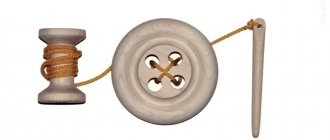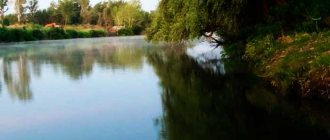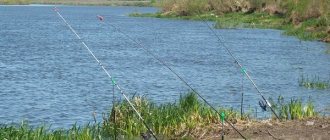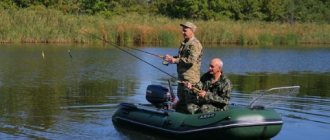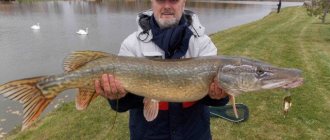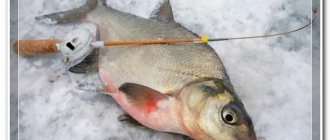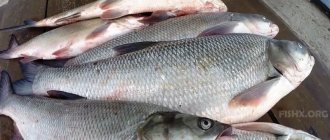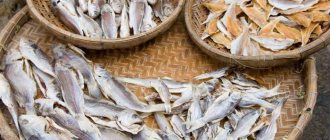Do bream bite on foam plastic?
There is an opinion that fish bite well on foam balls only in spring and summer. However, this is not entirely true, because in the fall there are considerable chances of catching especially large specimens both in rivers with strong currents and in reservoirs with standing water. It should be remembered that at this time of year the fish gather in schools, so if you manage to find the habitat of bream, you can count on a rich catch.
Unlike their underwater counterparts, bream calmly tolerates cold water. This feature allows you to fish from the shore with the onset of noticeable autumn cold. However, if September turns out to be warm, then you won’t be able to catch fish from the shore, as they move closer to the cool bottom holes. As the water temperature drops, the prey approaches the shore and remains there until approximately mid-November, after which it again swims away to bottom holes and other shelters.
Did you know? The largest specimen of bream was caught on a hook in England. The record was recorded in 2014. The weight of the fish was 7.1 kg.
Bream and foam
There is no single point of view on what attracts fish to foam balls (expanded polystyrene). Fishermen cite the following reasons:
- External resemblance to plant grains. The effect is enhanced by tinting. Practical experience suggests that the most attractive colors for bream are white and yellow . And the sizes should not differ much from the grains washed out of the feeder.
- Movement in the water column. Due to its uniquely low density, a particle of polystyrene foam constantly strives towards the surface. The leash and hook prevent floating. The current interferes with this process, and the struggle goes on with varying degrees of success. The ball constantly moves and attracts the attention of the fish. In any flock, an individual strives to be the first to grab prey. A noticeable, bright granule falls into the field of view faster than others and becomes the target of attack.
It is believed that polystyrene balls are perceived by fish as garbage. To get to the contents, the bream filters all the water near the feeder through its gills and accidentally swallows the bait.
How to choose bait for bream
Spring bait
To fish in reservoirs with a current, it is necessary to add viscosity ; for this, clay from the reservoir and pea flour are used. Fraction : small, but always with the addition of large pieces of live maggots and food bloodworms. Color : light Smell : coriander is the best option Additives to attract large fish: instant corn, crushed peas, scalded maggot
Summer baits
In the summer heat, many complain about a complete lack of bite , but this is not always true. Properly selected bait can attract the attention of bream even in the heat. June: worm, maggot, corn, peas, pasta. July: steamed barley, maggot worms in the form of sandwiches. August: bread, pasta, corn, maggot worm. Temporary decreases in temperature indicators will entail a return of bream to animal types of bait ; vegetable bait should be offered in hot weather.
Autumn lures
In the autumn, bream continue to be actively caught on the feeder; groundbait and bait, as before, should work in tandem in such gear. As the temperature drops, bream will again want “meat” baits. September: earthworm and dung worm, maggot, hominy, bread, steamed cereals. October: bloodworms, worms, less often maggots. November: maggots and bloodworms, plant-based baits will not work. It is important to understand that the bait used in crushed form must be added to the bait.
Winter lures
In winter, bait for bream is very important; it is more difficult for passive fish to attract attention . Therefore, the selection of bait should be approached very carefully. December: sandwiches made from pieces of worms, bloodworms and maggots, less often boiled peas are used. January: bloodworm, worm. February: worm, bloodworm, semolina, peas. You can experiment and try using the dough as bait; at the end of February, bream can respond well to this species.
When is the best time to catch
Experienced fishermen claim that bream bite best at night. However, in order to get a good catch, the fish need to be baited. It is better to start feeding in the evening, throwing the bait in the same place every 10–20 minutes. This should be done as quietly as possible, since bream is quite sensitive to sounds.
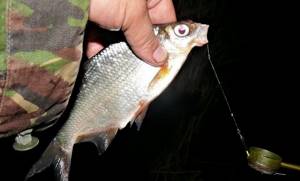
In ponds with stagnant water, it is best to catch this representative of the underwater world from the shore using a fishing rod near cliffs or underwater edges. When fishing in rivers with a current, you can either approach the bream habitat by boat or fish from a bridge or cliff, using long-casting gear.
What type of foam should it be?
Foam balls for catching bream can either be purchased at a fishing store or made independently by simply crumbling a piece of building material and painting it in different colors.
It is not known why prey reacts better to colored material, choosing, as a rule, light balls. There is an opinion that white foam reminds fish of plant seeds, and yellow one looks like boiled corn, but this is just an assumption. There is another version. Allegedly, the fish perceive the foam as garbage and try to discard it from the bait, getting hooked.
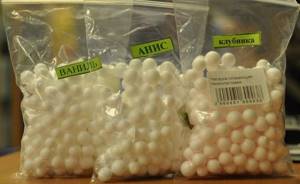
Like its river brothers, bream is very sensitive to all kinds of aromas. As bait, you can use polystyrene foam rubbed with vanilla or garlic. In order for the material to retain its scent for as long as possible, experts recommend immersing it in an aromatic solution for 5–10 hours. In a small pond, foam treated in this way can attract bream from literally all over the pond.
Here you can read how to bake bream in the oven.
Leash for fishing bream using foam plastic
For fishing, leashes are used that are slightly longer than the height of the feeder. That is, the foam ball should float at a level of 1-3 cm from the surface of the bait in the feeder.
The length is selected depending on the chosen hook and the fish that you plan to catch. The most important thing is that the leash should be soft, so many fishermen recommend using braid with a diameter of 0.1 mm as the material for the leash.
I use regular fishing line with a diameter of 0.1 mm to 0.2 mm. When fishing, I rely more on the drag of the reel than on the thickness of the fishing line.
How to hook
When choosing a hook for a foam attachment, you should give preference to the standard options. Their sizes range from No. 6 to No. 8 for small balls designed for catching small fish, and No. 10–14 for larger specimens.
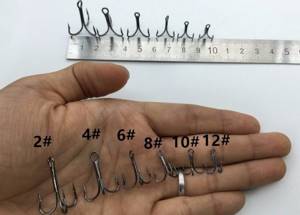
When placing the foam on the hook, the ball should be positioned in such a way that it cannot easily slide off in the water, yet remain attractive to prey. Fishing enthusiasts claim that when fishing for bream, you should use only black hooks. Silver or metal gear scares away fish.
Bait when fishing with foam
When catching fish using polystyrene foam, you cannot do without high-quality complementary food. To attract prey, both plant and animal components of baits are used.
Important! When fishing for bream, it is important not to overdo it with bait, since excess aromas will discourage the fish from biting.
Thus, the most popular components among fishermen are the following:
- bran;
- millet;
- Hercules;
- boiled corn kernels;
- semolina;
- dough;
- crushed worms;
- bloodworm.
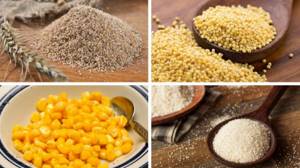
Feeders are also mounted on the gear. When fishing in reservoirs with stagnant water, it is better to use standard round products, while in rivers with strong currents it is better to use triangular and flat models, from which bait is not washed out so quickly.
Fishing with polystyrene foam and details of gear preparation
Today we offer the topic: “fishing with foam and details of gear preparation” from professional fishermen. We tried to cover the topic as fully as possible. You can ask all questions in the comments after the article.
The quantitative composition of fishing baits these days is impressive in its diversity, and sometimes the dilemma of choice is acute when planning even the most ordinary fishing strategy. The right choice definitely increases the results of the catch, but it is not always possible to make it correctly and in this case the criteria for the versatility of the nozzle come to the fore. One such solution is the use of foam balls for fishing.
The similarity of the forms of the material with natural food objects familiar to most peaceful fish, as well as the ease of creating a variety of colors and imparting a smell that attracts fish, made the use of this product an effective universal tool under many fishing conditions. In addition, the foam ball is extremely convenient in terms of reliable fastening on the hook and long-term storage, which does not require absolutely any conditions. Even these few arguments speak of the convenience and wide range of possibilities for fishing with polystyrene foam.
For those fishermen who have not yet tried this bait in practice, this article will reveal the main secrets of fishing with foam balls and will help to securely secure it in the arsenal of fishing baits on an ongoing basis.
Fishing with foam plastic, in addition to the advantages of the shape of the material, has many other fundamentally important advantages. The very essence of the application is based on the physical properties of the material. Firstly, due to low density and high buoyancy, the balls are always afloat with a tendency to rise to the surface. Secondly, even with a low density, the porous structure of the material allows you to firmly secure the hook in the body of the nozzle, without fear of its loss when casting over the longest distances. An important feature is the insolubility of foam, from which we can conclude that the nozzle is long-lasting and does not require replacement.
Foam baits are used both in reservoirs with a current and in stagnant ponds heavily silted with bottom sediments. Leashes with attachments carried by the current give an attractive style of play that attracts fish. In stagnant reservoirs, with the correct selection of the leash length, the bait will never get stuck in the silt and will be on the surface of even the softest bottom sediment, constantly attracting a passing trophy with its appearance. To make foam baits more attractive, they are painted in promising colors and impregnated with all sorts of attractants, which flavor the balls for a considerable time, making them similar to boilies popular in carp fishing.
Foam fishing is characterized by a tendency towards versatility, not only in the direction of the bait, but also in the direction of the object of hunting. After all, using this type of bait, the catch may include both peaceful fish and some species of predator. The category of peaceful fish caught on foam plastic imitations includes all carp. For some types of fish, fishermen have developed specialized fishing strategies with their own nuances of technical design, equipment and special equipment.
Crucian carp, carp, bream, roach, and silver bream are among the main prey items. Bleak, gudgeon, rudd, ide, and chub confidently complement the presented list of species. Among the predators caught on foam plastic imitations are perch and pike perch, especially if fishing occurs on currents when the bait is animated by strong jets of water. Using the possibilities of the current, many representatives of salmon fish are caught in natural conditions, on fast streams and rivers. Grayling and trout happily pick up colorful foam peas playing in the streams of water.
Installing fishing gear for polystyrene foam is no different from installing fishing gear with other baits. To a greater extent, this bait is used for fishing reservoirs with bottom gear, hooks and feeders. Float tackle is used much less frequently and for smaller species of fish. Flying, Bolognese and match gear are selected based on the size of the fish planned to be caught and the range of bait delivery. Mono lines up to 0.15 mm are used as the main cords. The floats and loading systems themselves depend on the fishing conditions and the bait has no influence on their selection. Hooks are used the size of a pea and try to use in light colors. For example, a steely metallic color goes well with white tones.
Important! Tackle for fishing with polystyrene foam for the bottom fishing method is equipped based on the volume and, accordingly, the mass of the feeder and the strength of the current in the reservoir.
The bait also does not have much influence on the composition of the rig. The only nuance is the use of soft, but memoryless monofilaments on leashes no thicker than 0.12 mm, which allows the balls to play along with the currents more naturally and more confidently float up from the silt deposits after casting. Carp are caught on heavy rods equipped with powerful traction reels. Feeder gear for roach can be equipped with a light pickerel with a reel for monofilament. Hooks for single baits are taken with a curve, without a forearm, based only on the diameter of the pea. Garlands of imitation boilies are placed on hooks with a long shank or using hair equipment.
Fishing practice has shown that the most successful time for using foam baits is the entire spring and early summer. In spring, the fish are less careful, hungry after the winter season and behave more aggressively in a school, obtaining food found collectively. These possibilities in fish behavior formed the basis for the successful use of the bait described above.
Important! The fundamental point of installing a foam ball on a hook for any fishing method is to release the free tip of the hook from the material.
It’s safe to say that in float fishing, foam baits replace maggots, dough and bread crumbs. Therefore, fishing tactics and techniques can be transformed from natural baits to artificial bait in float fishing, without any doubt. As for bottom fishing, there are features of bait supply and nuances of installation settings. Next, using the example of hunting for bream and crucian carp, we will consider the differences in the use of polystyrene foam baits in relation to natural baits.
Bottom fishing for crucian carp using polystyrene foam is organized using a feeder.
Important! The feeder is selected in the form of a spring that can accommodate a volume of complementary food from 70 to 100 grams.
The size and volume of the feeder meet the criteria for crucian carp hunting in silted stagnant or weakly flowing reservoirs, when the feeder in most cases falls into the bottom sediments and does not work directly, dispensing portions of complementary food that floats up and settles in small quantities as a spot on the surface of the silt. It is above this spot that the floating polystyrene foam balls should be located, mounted on leashes of the required length.
Having put the ball on the hook, it is inserted into the bait and fed into the fishing zone. After feeding, the complementary food dissolves, releasing the hooks. The crucian carp, collecting particles of food on the surface of the silt, also sucks in the hook with foam, thereby hooking itself on the tackle. The bite comes out sharply, without first testing the bait. To be on the safe side, the angler makes a control mark and fishes for the trophy. In one installation, it is possible to use up to five leashes, which, of course, increases the angler’s chances of the frequency and success of biting.
Bream fishing for polystyrene foam is carried out in weak and moderate currents using mesh feeders with dusty complementary foods.
Important! The leash in the installation is knitted in such a way that it is pulled together by the force of the current in the direction of the movement of the bait train and is pressed as close to the bottom as possible, but does not lie on the bottom base, constantly playing along.
To attach the pea, the installation method can be used either with direct stringing of the nozzle on the hook, or with hair equipment. Leashes are used in lengths from 30 to 50 cm, adjusting the pressure to the bottom by selecting the optimal weight of the bait, which depends on the forces of the current and the weight of the bait itself. The bream, having discovered a tasty trail, moves along the path, collecting tasty particles, sucking up food objects of similar shape and appearance as it moves, which is what the polystyrene foam simulator with a hook is.
Self-cutting occurs when the fish releases the ball through the gills, where the hook's sting digs into the fish's body. Fishing involves raising the trophy to the surface of the water, where after the first breath of air the fish calmly pulls itself towards the fisherman, becoming his lawful prey.
It is no secret that polystyrene foam works only with the use of groundbait and groundbait is not simple, but with dusting properties, if we are talking about using the composition in a reservoir with a current, and the possibility of dissolution with the floating of particles, if fishing is carried out in stagnant ponds.
Fishing technique and tactics
When planning fishing on a river with a strong current, you should consider some features. So, first of all, you should not approach the fishing site on a motor boat with the engine running. It is better to turn off the engine 100 m before the feeding area. In addition, you should take care of a reliable anchor so that the current does not carry the boat away. A jerk from a large fish can also change its position.
Did you know? In Russia, the largest bream are found in the Oka River.
Casts should be made in the direction of the current, and when a fish gets hooked, the prey should not be allowed to move towards the shelter. As a rule, these are snags and underwater holes. Such fishing maneuvers can tear the fishing line or even break fishing gear. In addition, you should remember to be as quiet as possible so as not to scare away the trophy.
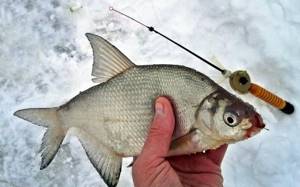
With the onset of winter cold, bream practically does not reduce its activity. In winter, this fish prefers to settle under snags, in flooded river beds, as well as in bottom holes or other shelters.
In cold weather, bream continue to move around the reservoir in a school. Here you can read how to deliciously fry bream in a frying pan.
Bait is placed in the feeders. Most often it is feed mixed with macadamia. For viscosity, you can add semolina. In addition, it is good to mix bloodworms into the complementary food, which is the favorite food of winter bream. It is also better to use it for bait. In addition to bloodworms, worms or moth larvae can be used as bait.
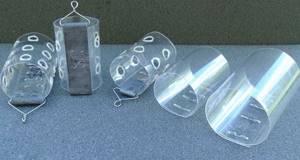
To effectively attract prey, winter fishing enthusiasts use deep feeders. They are often ordinary plastic bottles with the bottom cut off and a fishing line or braid attached to the neck.
Fishing never ceases to be an exciting activity even in the cold season. In addition, anglers have a real chance to catch particularly large fish that are not found during the warm season.

